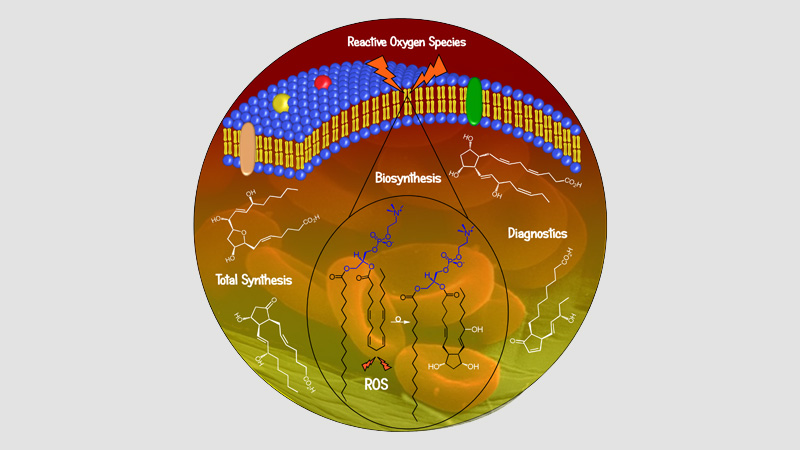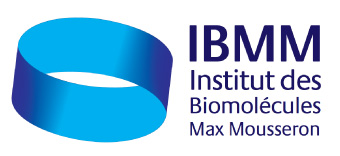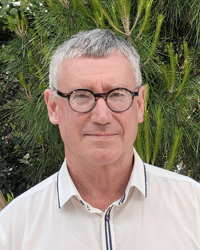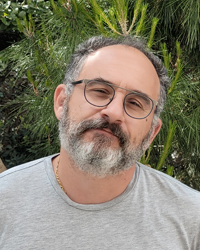The team is directed by Thierry Durand. Jean-Marie Galano is the Deputy Director
- Total synthesis of oxidized metabolites of various unsaturated fatty acids: Iso-, Neuro-, Phytoprostanes, Iso-, Neuro-, Phytofurans, dihydroxy-PUFAs (PD1-diHAdA..), Iso-, Neuroketals, FAHFAs, lipophenols and lipopeptides.
- LC-MS and GC-MS quantification of these oxidized metabolites in various human, animal and plant matrices.
7 major areas of research are developed in the team. Through various collaborations with biologist and clinician colleagues, these metabolites have enabled us to study their original biological activities and their use as biomarkers. We have also developed expertise in LC-MS quantification methods for these cyclic oxidized metabolites (isoprostanoids).

Our Themes
Total synthesis of bioactive lipids
Thematic 1 : Total synthesis of bioactive lipids:
1-1) (PI Jean-Marie Galano and Camille Oger) for the isoprostanoids/isofuranoids assisted by Valérie Bultel-Poncé and Alexandre Guy.
Radical peroxidation of polyunsaturated fatty acids (PUFAs), major constituents of cell membranes, leads to numerous cyclic oxidized metabolites, such as isoprostanes and their derivatives epoxy-isoprostanes, neuroprostanes, dihomo-isoprostanes, as well as isofurans, phytofurans, neurofurans. Enzymatic oxidation of PUFAs also leads to isolevuglandin-like non-cyclic metabolites, the ketals. Certain isoprostanes are now one of the most significant markers of cellular oxidative stress used clinically. These oxidized lipids also possess a broad spectrum of biological activities (anti-arhythmic, anti-inflammatory, neuroprotection, cardioprotection, VIDD, anticancer, etc.).
1-2) (PI Laurence Balas) for the diH-PUFAs and FAHFAs
Enzymatic oxidation of PUFAs by lipoxygenases leads to numerous dihydroxylated non-cyclic metabolites (PD1, diH-AdA, protectins, linotrines…) with potent activities on the resolution of inflammation.
The esterification of hydroxylated saturated or monounsaturated fatty acids with other saturated or monounsaturated fatty acids leads to “fatty acyl esters of hydroxyl-fatty acids (FAHFA)”, which are thought to be important in the regulation of type II diabetes.
1-3) (PI Camille Oger) for the Synthesis of marine enzymatic oxylipins (Ecklonialactones, sacrolide A) assisted by Alexandre Guy
Synthesis of marine enzymatic oxylipins (Ecklonialactones, sacrolide A) with potent bactericide activities.
Total synthesis of lipophenols
Thematic 2 :Total synthesis of lipophenols
2-1) (PI Céline Crauste) for the lipophenols as anti-carbonyl and oxidative stress in retina and neurodegenerative diseases
2-2) (PI Céline Crauste) for the natural lipophenols, discovered in EVOO
The coupling of polyphenols and PUFAs leads to lipophenols, of therapeutic interest in eye-related diseases (AMD, Stargardt). More recently, we have synthesized and discovered natural lipophenols in olive oil.
Synthesis of lipo-oxadiazolone to fight Mycobacterium tubercolosis
Thematic 3 : Synthesis of lipo-oxadiazolone to fight Mycobacterium tubercolosis
(PI Céline Crauste), assisted by Alexandre Guy.
Synthesis of lipopeptides and their analgesic activities on probiotic bacteria
Thematic 4 : Synthesis of lipopeptides and their analgesic activities on probiotic bacteria
(PI Jean-Marie Galano) assisted by Alexandre Guy
The coupling of lipids and certain amino acids leads to lipopeptides of therapeutic interest in diseases linked to the intestinal microbiota and gastric pain.
Total synthesis of fluorescent probes of neuroprostanes
Thematic 5 : Total synthesis of fluorescent probes of neuroprostanes
(PI Jean-Marie Galano) assisted by Valérie Bultel-Poncé
This project is based on Syntheses of multi-functional bioorthogonal probes capable to a/manipulate the lipid levels with organelle-specificity b/visualize and confirm its location of action in intact cells, and c/ fish for lipid-binding proteins.
Quantification of non-enzymatic isoprostanoids by LC-MS / MS
Thematic 6 : Quantification of non-enzymatic isoprostanoids by LC-MS / MS (Targeted lipidomics)
(PI Claire Vigor), assisted by Valérie Gros and Guillaume Réversat.
Looking for the unknown oxylipins
Thematic 7 : Looking for the unknown oxylipins: Similarity analysis and molecular networking.
(PI Jean-Marie Galano)
Molecular networking offers the possibility to link MSMS pattern of detected feature related to oxylipins in order to understand the complexity of oxylipin metabolites.


 Thierry DURAND
Thierry DURAND Jean-Marie GALANO
Jean-Marie GALANO






